The role of the cloud in digital transformation
As companies recover from the aftermath of the COVID-19 pandemic lockdowns, digital transformation has become more vital to business than ever before. Before 2020, digital solutions were nice to have. Now, for many companies, they're the only way work gets done. And the cloud is an essential part of that change.

You likely already use some kind of cloud-based software in your day-to-day operations. Video conferencing platforms, for example, have become the de facto method of meeting with co-workers and customers remotely. And web-based file access systems enable teams to access company data and applications from anywhere there's an internet connection and an approved device.
Most companies that launch digital transformations fail because they expect outdated IT infrastructure to support significant increases in digital demand. The companies that succeed leave behind their legacy systems to work toward full cloud integration. Wherever you are on your path toward digitalization, adopting a cloud-first strategy can significantly improve your chances of meeting your digital transformation goals. This post will show you how.
What is digital transformation?
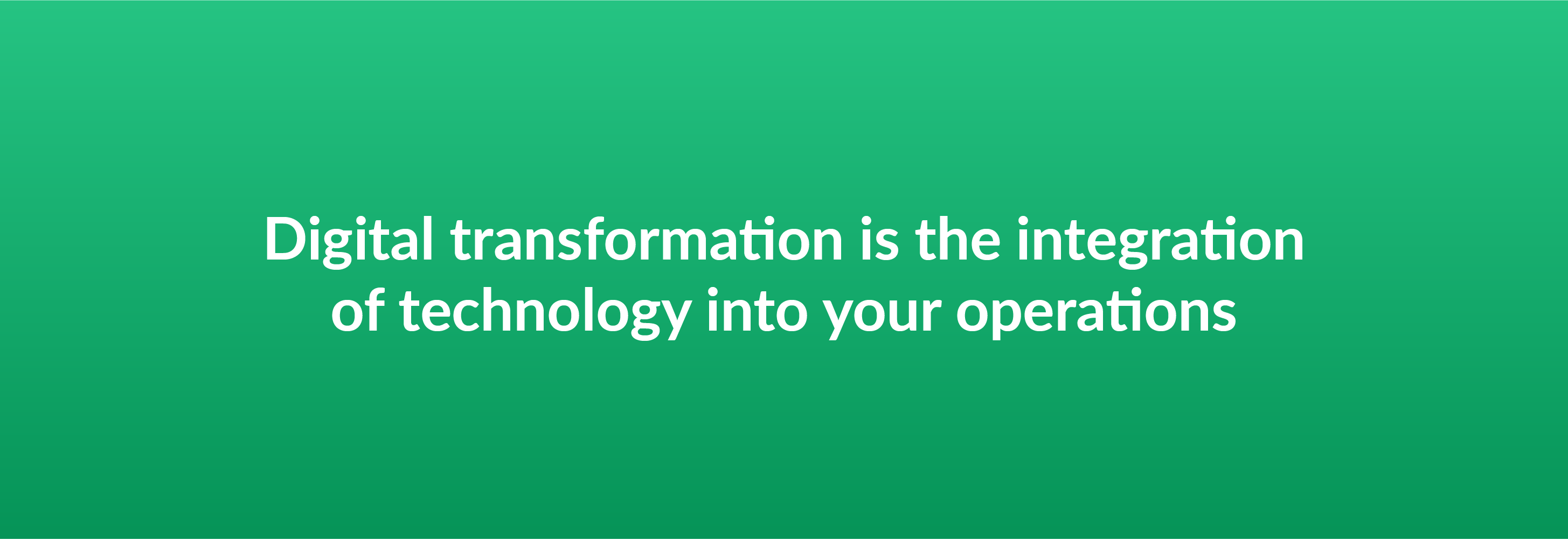
Digital transformation involves integrating digital technology into every part of your organization and business strategy. This process fundamentally changes the way your business operates, including how you serve your customers.
That said, every organization has unique technological needs, so digital transformation looks different from company to company. Organizations in the hospitality and service industries might begin by going paperless on the back end, while companies managing complex inventory systems, like manufacturers and retailers, often begin by adopting warehouse management software.
Every company is in a different place on its journey of digital transformation, but many feel under pressure to accelerate their efforts right now. Often, companies find that they need to abandon traditional business practices to implement new solutions. Your organization can experiment and continuously evolve to develop innovative solutions that move your business forward.
No matter where you are in your own digital transformation, you can achieve success for your organization. You just might have to be willing to step out of your comfort zone.
Why is digital transformation so important?

Just look at how much the nature of work has changed over the past few years. After the pandemic forced companies to halt in-person operations and pivot to remote work, most people who can work outside the office now prefer to work remotely at least some of the time.
To account for this shift, organizations are increasingly adopting hybrid work models where people have the ability to work both remotely and in the office. This kind of work is only possible thanks to the widespread adoption of cloud-based digital technology.
Other areas of business are also experiencing dramatic shifts in processes and expectations. If you can't respond quickly to unforeseen issues like supply chain disruptions and rapid shifts in consumer behaviors, existing processes will inevitably lead to critical breakdowns.
Digital transformation is essential for ensuring your company's survival. Whether you're a small-to-mid-sized business (SMB) or an enterprise company, prioritizing your digital transformation is critical for success.
Starting with a problem
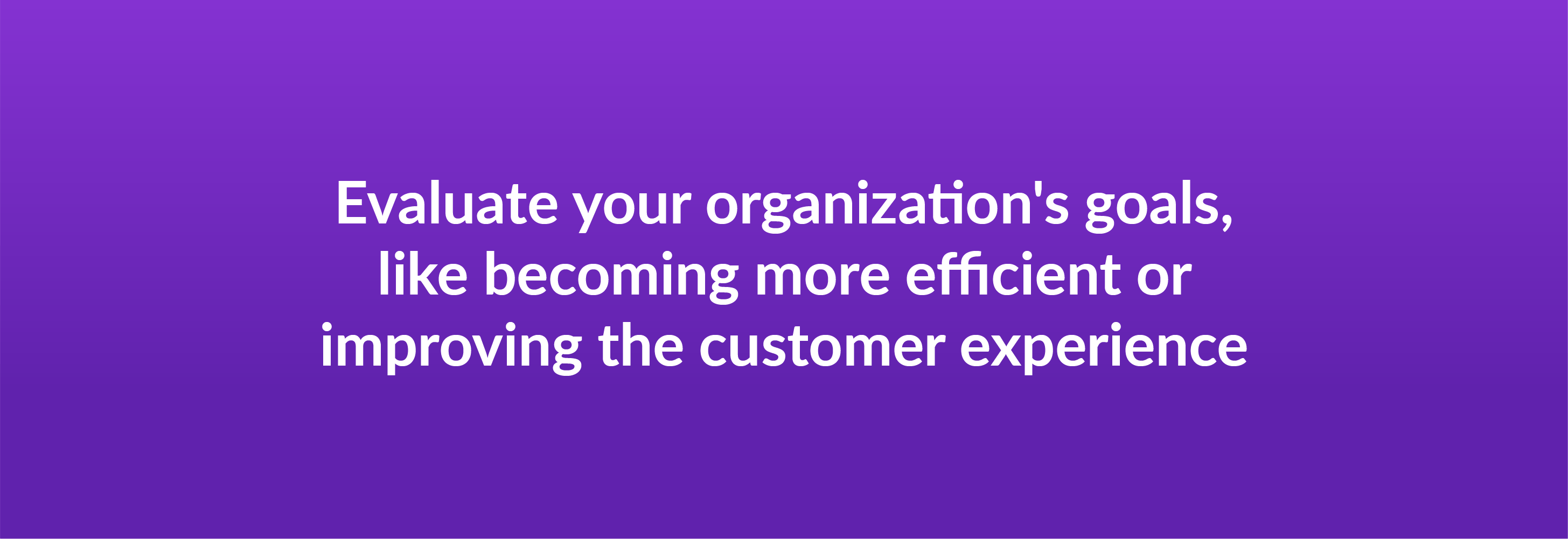
Every successful digital transformation begins with a clear idea of an organization's goals. What problem will digital transformation solve? How will digitizing improve your organization? According to a global study of 414 chief information officers (CIOs), the top three business priorities for organizations undergoing digital transformations include:
- Increasing operational efficiency
- Transforming existing business processes
- Improving the customer experience (CX)
Once you know your “why,” you can brainstorm what steps you need to take to achieve your goal. You'll also have a clear reason to continue the project, which can help you avoid hitting a plateau in your transformation.
By leveraging digital technology that was previously unavailable, you can find new ways to reach these goals. And it all begins with the cloud.
The driving force behind digital transformation
Cloud migration is more than just a box to check off during digital transformation, It's integral to achieving your technological goals.
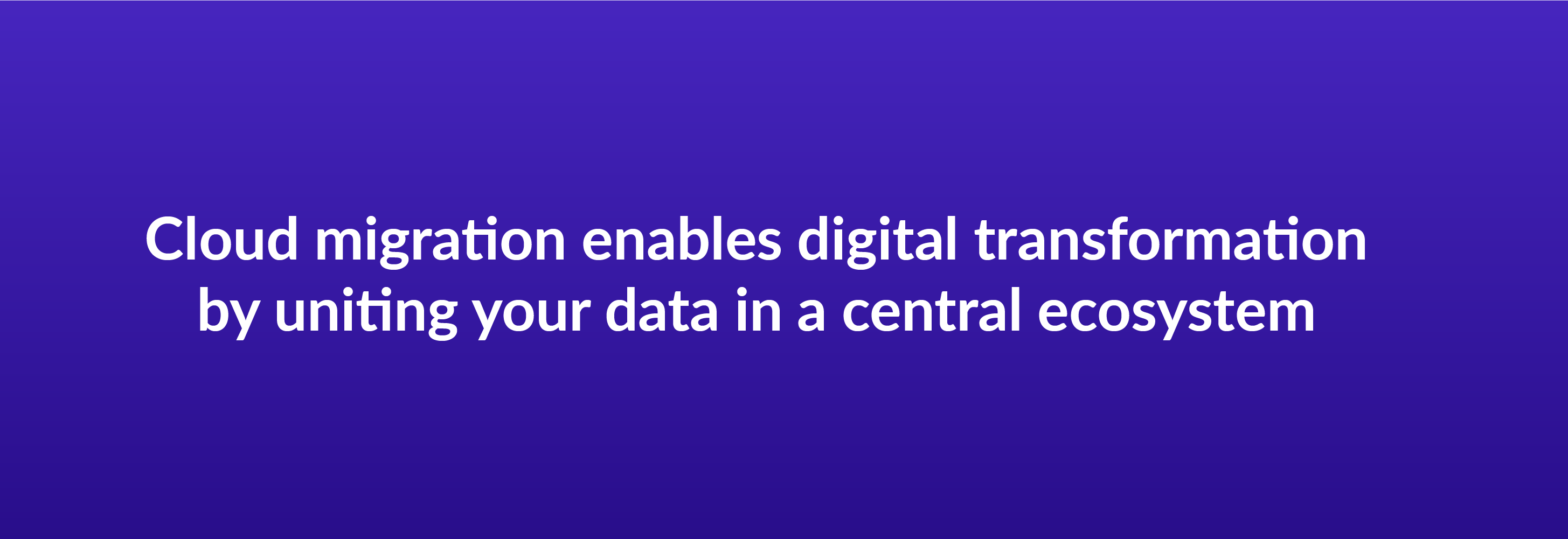
Building on your existing infrastructure may seem like an easy way to save money, but it's usually more expensive in the long run. When you consider the ongoing costs involved in maintaining and managing legacy infrastructure, you're looking at a significantly higher long-term cost than investing in a scalable cloud solution, which you can easily adjust when your needs change.
In addition, rather than bringing in new technology piece by piece and hoping it works together, moving to the cloud allows you to use software integrations to create a smoothly running digital ecosystem. And by centralizing all your data, you can completely transform your entire business strategy rather than just a few processes. This approach connects your organization and makes it easier to meet the evolving demands of the future without breaking your budget.
Additionally, a cloud-first approach keeps your business viable even during times of crisis. The cloud enables smooth and effective remote work and keeps you connected to your customer base and business partners. Whether there are natural disasters or global catastrophes, the cloud protects your data and keeps operations running smoothly, minimizing financial and reputational losses.
The cloud also helps improve CX. Because the cloud enables real-time updates and easy access to your organization's data, you can gain more accurate insights into your customer demographics and behaviors, allowing you to find new ways to provide a more personalized experience and foster brand loyalty.
Upgrading to cloud infrastructure benefits customers, improves team efficiency, and drives up productivity at work. Unlike legacy systems, the cloud is flexible and can adapt to each individual's unique workflow, empowering them to tackle their work in new and innovative ways.
Embracing the cloud

Digital transformation and cloud adoption go hand in hand. Without cloud adoption, a digital transformation is essentially incomplete. It makes sense, then, that 85% of enterprises are projected to adopt a cloud-first business model by 2025.
A cloud transformation — a cloud-centric approach to digital transformation that prioritizes cloud adoption — makes it easier and faster to digitalize, streamlining the path to complete and sustainable digital transformation. Key components of a successful cloud transformation include the following.
Creating an effective strategy
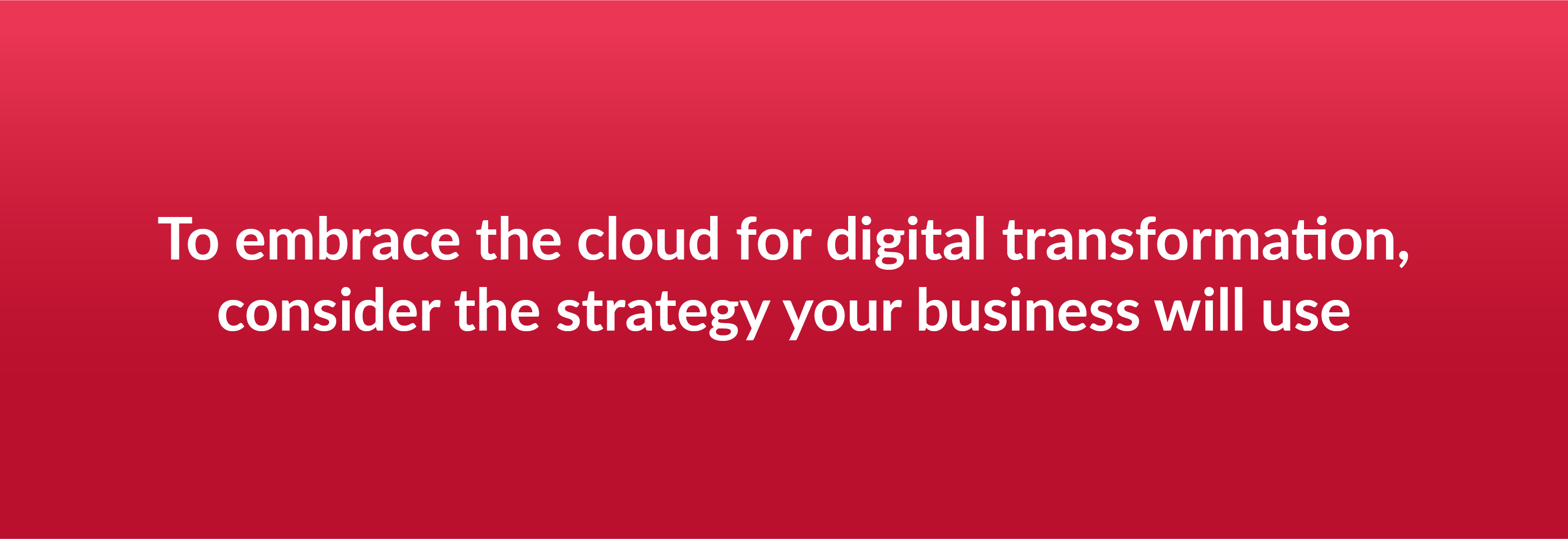
Good data drives sound business decisions. Benchmarking where your organization currently stands in regard to your competition is a good step forward because it helps you determine how far you are from your goals and how to invest your time, effort, and resources to close that gap.
One such consideration is whether you will invest in a single-cloud strategy or spread your resources across multiple clouds. A single-cloud model is simpler and easier to manage for organizations that have less demanding technology needs, like SMBs and companies that do most work in a single office.
On the other hand, building a multi-cloud ecosystem can benefit enterprises that have more complex needs because each cloud provider can help with specific tasks and processes it's best at. For instance, you might use one cloud service for team collaboration and another for organizational communication.
Finding the right cloud service provider

Although we refer to “the cloud” as a singular entity, it's not a monolith. There are hundreds of cloud service providers (CSPs) out there, each with their own unique value propositions.
The provider you choose will depend heavily on factors like your organization's size, your industry, and your goals. You'll know you've found the right provider when they meet criteria like:
- Technology and services which are compatible with your existing tech stack
- An excellent, verified performance record
- Crisis management provisions such as disaster recovery
- A business model that allows you to easily switch providers if you find a better match for your company
It can help to consult with multiple providers before settling on one. Many offer free trials or live demos, which are great for getting an insider's look into how each cloud operates and how the company meshes with your own.
Putting security first

Security is key in a successful cloud transformation strategy. Thankfully, you can easily incorporate it into your digital transformation roadmap.
When you're planning your cloud strategy, it can help to assess your current IT security measures and compare them to where you would like to be. This step will help you determine what you need to do to close the gaps between your current cybersecurity status and your target. Knowing what you need can also help you choose a CSP.
Many CSPs offer built-in security controls that keep your data and applications from malicious actors both internally and externally. By working with your CSP to eliminate risks before deployment, you'll get secure, scalable virtual environments that operate how you need them to.
Outlining a cloud migration schedule

Digital transformation is a gradual process. It's important to strategize which systems you'll migrate first to ensure a smooth transition.
Most enterprises that manage a successful digital transformation begin by migrating one portion of their data centers at a time. Some companies begin with the areas that already have built-in cloud support, like email and instant messaging. Others start by moving data from systems that are approaching end-of-life status in order to prevent potential data loss.
If you're unsure where to start, taking advantage of cloud migration services can help you successfully execute your migration. Many CSPs have automated tools at their disposal to accelerate the process, so you can move to the next phase of your digital transformation quicker.
Why move to the cloud?
Cloud transformation has an enormous impact on the way you do business. Migrating to the cloud improves your competitiveness, resilience, and agility, which increases revenue and reduces costs.
Done well, a cloud-backed digital transformation can benefit your organization by enabling:
Streamlined workflows

The cloud can help you optimize the way your organization works, from saving time on simple tasks to eliminating frustrating inefficiencies that get in the way of critical steps.
Legacy systems limit you to in-person work only. Cloud services, on the other hand, enable collaboration anywhere, from any device, at any time. This flexibility allows you to adopt a hybrid or remote work model so your people can do work wherever they're most productive, whether that's the office or the kitchen table.
Traditional infrastructure is also prone to unnecessary redundancy, which can seriously slow down your systems. Cloud-based solutions help eliminate redundant communications and documents to increase system speed and reduce server noise. As a result, your people will save time previously spent waiting for programs to load, allowing them to focus completely on their work.
If your organization still relies on paper-based filing systems or hard-drive storage, you know how long it can take to find the documents you need amid the sea of similarly named files. Many CSPs offer artificial intelligence (AI)-powered search and organization features that can locate files within seconds so you can get to work right away.
Efficient operations
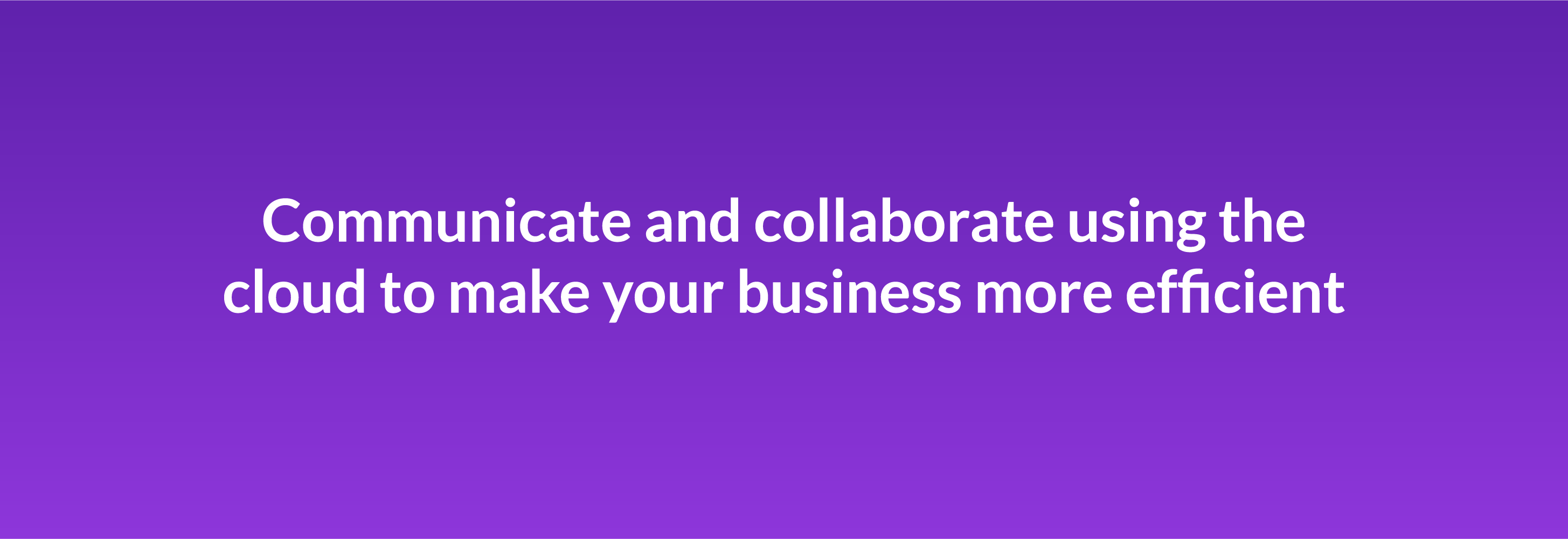
Minor process snags may take only a few minutes to resolve, but they add up over time, which can harm your organization's efficiency. Tools like cloud-based collaboration and communication solutions save time by allowing team members to work from anywhere. Without spending time waiting for everyone to be in the same room, your people can get started on time-sensitive tasks right away and deliver results much faster.
Cloud computing solutions enable enterprises to adopt a development operations (DevOps) culture, which combines development and IT staff into one team and effectively eliminates development bottlenecks. Using cloud-based technologies like virtual machines, self-service catalogs, and automation, DevOps teams can get work done without waiting for IT to provision resources for them — as a result, you can get products to market faster.
Cloud solutions also make it easier to get feedback on your products from customers and corporate end users. With a streamlined feedback loop, your people can get to work fixing bugs and making improvements faster, resulting in speedier time-to-market and higher-quality products.
Reduced risk
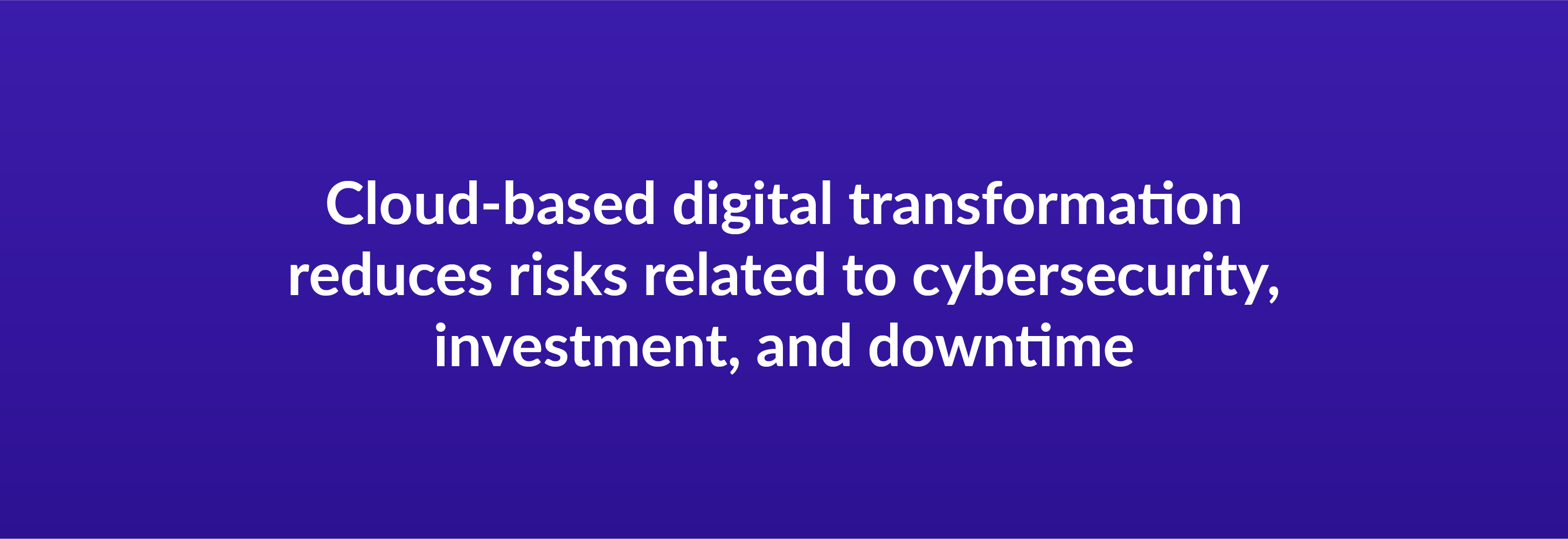
CSPs can offer end-to-end cybersecurity technologies to protect your data from malicious actors both while in transit and at rest, including:
- Zero-trust architecture
- Multi-factor authentication
- Advanced file encryption
- Intelligent threat detection
Investing in outdated IT infrastructure will result in sunk costs when you can no longer use the equipment or when you purchase equipment that is too large for your actual needs. Because cloud solutions are highly scalable, you only pay for the space and services you actually use. If your needs change — for example, if your remote workforce grows — you can scale accordingly.
Downtime is another major problem with traditional infrastructure. When it happens, you're stuck waiting for your IT team to resolve the issue, which can take hours or even days. Poorly managed downtime can result in enormous financial losses, which is why cloud crisis management services, such as disaster recovery, are critical for restoring your data and getting back to business as quickly as possible.
Innovative business processes

The cloud offers endless possibilities for innovation. When you adopt cloud services, you gain access to hundreds of cloud-native technologies and features that can help you streamline your business processes and drive increases in revenue.
Your organization's ability to innovate can improve, too. Scalable cloud-based software provides the support you need to develop new products, services, and capabilities at a more demanding pace. You'll be able to increase your company's strategic value by leveraging new business opportunities in areas you may have previously overlooked.
Discover the power of the Content Cloud
With a single secure platform for all your content, Box enables you to manage the entire content lifecycle: file creation, co-editing, sharing, e-signature, classification, retention, and so much more. We make it easy for you to collaborate on content with anyone, both inside and outside your organization. Frictionless, enterprise-grade security and compliance are built into our DNA, so you get total peace of mind that your content is protected. And with 1,500+ seamless integrations — as well as a range of native capabilities, like Box Sign — the Content Cloud provides a single content layer that ensures your teams can work the way they want.
The Content Cloud is a game changer for the entire organization, streamlining workflows and boosting productivity across every team. Contact us today, and explore what you can do with Box.
**While we maintain our steadfast commitment to offering products and services with best-in-class privacy, security, and compliance, the information provided in this blog post is not intended to constitute legal advice. We strongly encourage prospective and current customers to perform their own due diligence when assessing compliance with applicable laws.